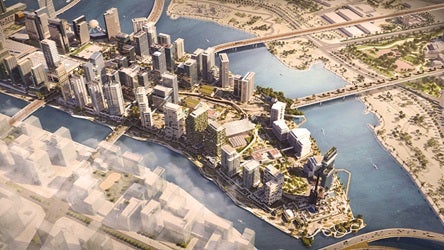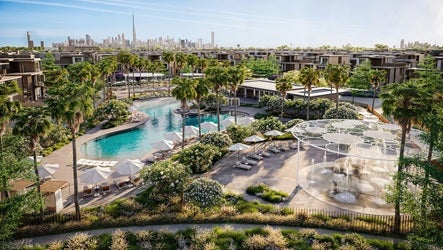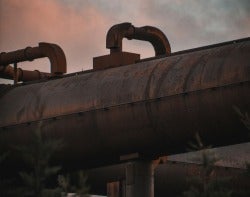Bridging the infrastructure capacity gap
2 April 2024

The Middle East and North Africa (Mena) region faces a massive infrastructure gap, with estimates of the shortfall ranging from $75bn to $100bn annually.
This translates to a cumulative need for $2-2.5tn in infrastructure investment alone by 2050. Bridging this funding gap will require a drastic increase in the level of investment.
In 2020, the World Bank stated that Mena countries needed to spend at least 8.2% of GDP to meet their infrastructure goals through to 2030. However, it had been averaging a spend of just 3% over the prior decade – mostly from public sector funds, alongside multilateral and bilateral debt financing.
In the intervening years, the additional fiscal constraints imposed by the pandemic and global economic shocks, such as food price inflation, have further hindered regional public spending on infrastructure.
In 2023, the ICD-Refinitiv OIC Infrastructure Outlook valued the region’s outstanding funding gap for infrastructure development at $994bn. The gaps included a $685bn shortfall in investment in road infrastructure; a $111bn funding gap in the water sector; a $65bn gap in telecoms; $47bn in rail; $34bn in port infrastructure; $27bn in electricity network investment; and $25bn in airport infrastructure investment.
This funding gap has real, material impacts on economic prosperity and the prospects for economic growth. The shortfall in investment in road infrastructure, for example, is estimated to cost the Mena region a staggering 5.5% in GDP a year due to inefficiency and accidents, according to the World Bank.
A 2020 study in the Review of Middle East Economics and Finance found that manufacturing firms in the Mena region faced the most severe durations of power outages a month of any region, at 64 hours a month. The perceived value of the business losses due to these power outages was estimated to be around 4.8% of total sales.
Meeting the region’s annual investment needs could generate about 2 million direct jobs and 2.5 million direct, indirect and induced infrastructure-related jobs, according to the OECD.
This is critical when half of the region’s population is under 24 years old, and 29% are not in employment, education or training, as per the OECD figures.
Another very tangible infrastructure gap is water capacity. The current annual water shortage in the Mena region is about 42 cubic kilometres, but by 2050, this is projected to grow fivefold to 199 cubic kilometres a year under average climate scenarios and potentially up to 283 cubic kilometres a year under drier conditions.
These examples highlight the need for substantial investments to bridge the infrastructure deficiencies, ensure the conditions for economic growth, and enhance overall sustainability in the Mena region.
To address the challenges, a comprehensive and multi-faceted approach is needed to incentivise the private sector to support regional infrastructure investments. This includes governments establishing clear policy directions and regulatory frameworks to attract private capital mobilisation.
This funding gap has real, material impacts on economic prosperity and the prospects for economic growth
Technological adaptation
In parallel with the need for governments to proactively improve the conditions for investment, the delivery of future infrastructure requirements also anticipates the adoption of emerging technology.
The goal of many countries to achieve net zero by 2050 also layers further complexity onto existing infrastructure challenges. Regional efforts such as the Middle East Green Initiative and the Circular Carbon Economy framework nevertheless demonstrate the region’s commitment to achieving its net-zero targets.
Reaching net zero will entail building infrastructure that is not just bigger and better, but smarter. At the Global Infrastructure Initiative Summit hosted by McKinsey in Dubai in February, disruptive thinking and technology were identified as vital to the industry’s evolution to meet the needs of a net-zero future.
Industry leaders called for a nuts-and-bolts overhaul of the industry from the bottom up, with more sustainable alternatives to even centuries-old staples such as Portland cement and rebar. The digitalisation of the industry and the advent of machine-learning and AI also hold huge potential for cutting waste and designing more organic, efficient structures.
The summit highlighted that solving future infrastructure requirements will also likely necessitate overcoming technology hurdles and bringing costs down through research and development, much like the costs of solar power or reverse osmosis desalination have come down in the region.
Alistair Green, a senior partner in McKinsey’s global infrastructure practice, pointed to the technologies that “are not at conviction, yet: the technology hasn’t even really been proven outside of the lab – like flow batteries, which are an alternative to lithium-ion batteries that can be used for grid-scale storage of long duration, energy storage. This is a technology problem that we’re actively investing in researching in order to bring the costs down.”
Strategy& and engineering consultancy Dar recently reported that sustainable construction technologies can potentially reduce lifecycle emissions from the Mena region’s $2tn construction pipeline through to 2035 by 50%-60% for planned projects. Simple changes can be highly effective, such as incorporating dynamic facades into building designs, which can deliver energy savings of up to 55% in hot countries.
The key is the level of innovation, not the level of technology. In the right application, a low-tech solution may be more efficient. If a low-tech solution is scalable, it is also likely to be more cost-efficient.
In the arid Ait Baamrane region of Morocco, a 2015 project by the NGO Dar Si Hmad has created the world’s largest operational fog-harvesting system, providing potable water using a system of shore-side nets that capture and condense the fog rolling in off the ocean. Launched after a decade of research, the system yields approximately 22 litres of water a day for each square metre of net. It demonstrates that infrastructure does not need to be expensive or complex to have a positive sustainability outcome.
The most pressing need for the Mena region is to improve the attractiveness of its infrastructure investment opportunities
Accessing finance
Without sufficient finance, the effectiveness of infrastructure development, including technological innovation within the sector, will be throttled. The most pressing need for the Mena region is to improve the attractiveness of its infrastructure investment opportunities.
Many governments, especially in the Gulf, have been focused on encouraging the private sector through better and wider public-private partnership (PPP) arrangements, with mixed results. Some countries have struggled to deliver PPP frameworks with sufficient commercial appeal and bankability, a problem usually linked to unattractive risk allocations on the private sector side.
Nevertheless, the mobilisation of PPPs and the creation of more transparent and efficient regulatory frameworks around them are routinely identified as vital for attracting and mobilising private capital.
The delivery of more sustainable infrastructure with a view to net-zero targets also brings the potential to tap into green finance, including green bonds and sharia-compliant sukuk. Projects targeted towards carbon neutrality open themselves up to more diverse avenues of potential finance, including international climate mitigation and adaptation funds.
Multilateral development banks, such as the Asian Infrastructure Investment Bank, support initiatives like the Catalyst Mena Climate Fund 2, which works to mobilise private capital for infrastructure projects focused on renewable energy, sustainable utility schemes and green hydrogen capacity.
Governments in the region are also taking steps to mobilise climate finance by issuing green sovereign bonds and sukuk to fund clean transportation, waste management and green building schemes.
The UAE’s infrastructure development is guided by the Green Agenda 2030 policy framework. Under this aegis, UAE banks, including Mashreq Bank and First Abu Dhabi Bank, have pledged to mobilise $270bn in green financing by 2030 for environmentally impactful projects.
Infrastructure financing schemes are an important step towards drawing more private sector liquidity into the infrastructure industry, but it is also just a start compared to what will be required to deliver the region’s infrastructure needs.
Deep regional inequality also needs to be addressed. While countries such as Saudi Arabia and the UAE may currently be meeting the World Bank’s 8.2% of GDP infrastructure spending targets, the region’s hydrocarbon importers will likely need far more outside assistance.
For the region as a whole to thrive, countries will also need to work together and synergistically to deliver holistic infrastructure roadmaps. Just as the GCC is working together to deliver the Gulf Railway, the Levant and North Africa must work together to develop their shared infrastructure.
Only through cooperation and joint initiatives will the Mena region stand to bridge its infrastructure gap.
Exclusive from Meed
-
 Regional rail industry emerges
Regional rail industry emerges8 December 2025
-
 Aldar and Mubadala plan $16bn financial district expansion
Aldar and Mubadala plan $16bn financial district expansion8 December 2025
-
 Visa agrees to support digital payments in Syria
Visa agrees to support digital payments in Syria5 December 2025
-
 Meraas announces next phase of Nad Al-Sheba Gardens
Meraas announces next phase of Nad Al-Sheba Gardens5 December 2025
-
 Frontrunner emerges for Riyadh-Qassim IWTP
Frontrunner emerges for Riyadh-Qassim IWTP5 December 2025
All of this is only 1% of what MEED.com has to offer
Subscribe now and unlock all the 153,671 articles on MEED.com
- All the latest news, data, and market intelligence across MENA at your fingerprints
- First-hand updates and inside information on projects, clients and competitors that matter to you
- 20 years' archive of information, data, and news for you to access at your convenience
- Strategize to succeed and minimise risks with timely analysis of current and future market trends

Related Articles
-
 Regional rail industry emerges
Regional rail industry emerges8 December 2025
 Commentary
Commentary
Colin Foreman
EditorRead the December issue of MEED Business Review
The GCC is experiencing a fundamental shift in its approach to rail infrastructure, as it moves from standalone projects to a self-sustaining regional industry. The transition is evident as local, national and regional projects advance across the region.
The first wave of metro systems, in Dubai, Doha, and most recently, Riyadh, have reported stronger-than-expected ridership and demonstrated the viability of mass transit in the Gulf.
Extensions to those networks are planned or under way, including Dubai’s Blue and Gold lines and Riyadh’s Line 2, alongside planned metros elsewhere such as Muscat and Bahrain.
Projects are also planned and already being delivered at the national level. The UAE’s Etihad Rail and Saudi Arabian Railways are leading most of these efforts. The region’s first cross-border project is also progressing with the Hafeet Rail scheme linking the UAE and Oman.
Other cross-border schemes are planned, including high speed links connecting Riyadh with Doha and Kuwait City, and rail links for Bahrain across causeways to Saudi Arabia and Qatar. The ultimate ambition is a GCC Rail network – a project that was reinvigorated by the Al-Ula accords in 2021.
Sustained, simultaneous activity across the GCC is fostering the development of an indigenous regional rail industry. Rather than being executed as isolated endeavours, projects are creating ongoing demand for expertise, personnel and resources within the region.
Project delivery capability will be complemented by the establishment of crucial ancillary services, including fabrication and servicing facilities.
These operations will shift the GCC from a lucrative market for international contractors to a regional hub for the rail industry, capable of servicing and sustaining its growing network.
 READ THE DECEMBER 2025 MEED BUSINESS REVIEW – click here to view PDF
READ THE DECEMBER 2025 MEED BUSINESS REVIEW – click here to view PDFProspects widen as Middle East rail projects are delivered; India’s L&T storms up MEED’s EPC contractor ranking; Manama balances growth with fiscal challenges
Distributed to senior decision-makers in the region and around the world, the December 2025 edition of MEED Business Review includes:
> AGENDA 1: Regional rail construction surges ahead> INDUSTRY REPORT 1: Larsen & Toubro climbs EPC contractor ranking> INDUSTRY REPORT 2: Chinese firms expand oil and gas presence> CONSTRUCTION: Aramco Stadium races towards completion> RENEWABLES: UAE moves ahead with $6bn solar and storage project> INTERVIEW: Engie pivots towards renewables projects> BAHRAIN MARKET FOCUS: Manama pursues reform amid strainTo see previous issues of MEED Business Review, please click herehttps://image.digitalinsightresearch.in/uploads/NewsArticle/15213797/main.gif -
 Aldar and Mubadala plan $16bn financial district expansion
Aldar and Mubadala plan $16bn financial district expansion8 December 2025
Register for MEED’s 14-day trial access
Abu Dhabi's sovereign wealth fund, Mubadala Investment Company, and local developer Aldar have established a joint venture to deliver an expansion of the financial district on Al-Maryah Island with a gross development value of AED60bn-plus ($16bn-plus).
The development will be built on the undeveloped land bank on the north side of Al-Maryah Island, covering about 500,000 square metres (sq m), and will support the next phase of growth for Abu Dhabi Global Market (ADGM).
The masterplan encompasses 1.5 million sq m of new office, residential, retail and hospitality floor space.
In an official statement, the firms said that the core objective of the project is to support the continued expansion of ADGM, Abu Dhabi’s international financial centre. ADGM now has more than 11,000 active licences registered in the free zone and is among the fastest-growing financial hubs globally.
"Nearly 40,000 people are already based within the district, and demand for space remains strong," the statement added.
The Al-Maryah Island expansion will add over 450,000 sq m of Grade A office space, doubling the island’s current office inventory.
The expansion will add over 3,000 residences on the waterfront.
The next phase will also add a further 40,000 sq m of retail and dining spaces.
A central feature of the expansion is the Al-Maryah Waterfront enhancement project. This will include a bay fountain capable of water displays up to 75 metres high, forming the focal point of a reconfigured waterfront with additional dining, leisure and event spaces designed to complement existing assets on the island.
Three new bridges are proposed to link the north side of Al-Maryah Island with Reem Island and the Abu Dhabi mainland, reducing travel time to Saadiyat Island to under 10 minutes.
The enabling works on these projects are due to begin in 2026.
The new joint venture is owned 60% by Aldar and 40% by Mubadala.
"The two organisations are close to completing the legal work on a retail joint venture that will own and operate several of Abu Dhabi’s leading retail destinations, including The Galleria Al-Maryah Island, Yas Mall and the planned Saadiyat Grove Mall," the statement added.
 READ THE DECEMBER 2025 MEED BUSINESS REVIEW – click here to view PDF
READ THE DECEMBER 2025 MEED BUSINESS REVIEW – click here to view PDFProspects widen as Middle East rail projects are delivered; India’s L&T storms up MEED’s EPC contractor ranking; Manama balances growth with fiscal challenges
Distributed to senior decision-makers in the region and around the world, the December 2025 edition of MEED Business Review includes:
> AGENDA 1: Regional rail construction surges ahead> INDUSTRY REPORT 1: Larsen & Toubro climbs EPC contractor ranking> INDUSTRY REPORT 2: Chinese firms expand oil and gas presence> CONSTRUCTION: Aramco Stadium races towards completion> RENEWABLES: UAE moves ahead with $6bn solar and storage project> INTERVIEW: Engie pivots towards renewables projects> BAHRAIN MARKET FOCUS: Manama pursues reform amid strainTo see previous issues of MEED Business Review, please click herehttps://image.digitalinsightresearch.in/uploads/NewsArticle/15213568/main.jpg -
 Visa agrees to support digital payments in Syria
Visa agrees to support digital payments in Syria5 December 2025
Visa and the Central Bank of Syria have agreed on a strategic roadmap that will allow the US-based card and digital payments company to begin operations in Syria and support the development of a modern digital payments system.
Under the agreement, Visa will work with licensed Syrian financial institutions under a phased plan to establish a secure foundation for digital payments.
The early stages will involve Visa supporting the central bank in issuing Europay, Mastercard and Visa (EMV)-compliant payment cards and enabling tokenised digital wallets – bringing the country in line with internationally interoperable standards.
Visa will also provide access to its platforms, including near-field communication (NFC) and QR-based payments, invest in local capacity building and support local entrepreneurs seeking to develop solutions leveraging Visa’s global platform.
“A reliable and transparent payment system is the bedrock of economic recovery and a catalyst that builds the confidence required for broader investment to flow into the country,” noted Visa’s senior VP for the Levant, Leila Serhan. “This partnership is about choosing a path where Syria can leapfrog decades of legacy infrastructure development and immediately adopt the secure, open platforms that power modern commerce.”
The move marks one of the most significant steps yet in Syria’s slow and uneven return to the formal global financial system and carries implications that reach beyond just payments technology.
It lays the groundwork for overturning more than a decade of financial isolation in which Syria has operated largely outside global banking and settlement networks.
Visa’s entry will not erase all existing barriers – as many restrictions remain in force and will continue to shape what is practically possible – but its support signals a reopening of channels that could smooth Syria’s reintegration into financial networks.
The involvement of the US-based payments provider is also a further tacit sign of the US government’s enthusiastic bear hug of the new post-Assad Syrian government under President Ahmed Al-Sharaa.
For investors assessing long-term opportunities, the presence of a globally recognised payments operator will provide reassurance that Syria’s financial system is returning to international norms, and the security and transparency that comes with it.
https://image.digitalinsightresearch.in/uploads/NewsArticle/15207198/main3225.gif -
 Meraas announces next phase of Nad Al-Sheba Gardens
Meraas announces next phase of Nad Al-Sheba Gardens5 December 2025
Dubai-based real estate developer Meraas Holding, which is part of Dubai Holding, has announced the eleventh and final phase of its Nad Al-Sheba Gardens residential community in Dubai.
It includes the development of 210 new villas and townhouses and a school, which will be located at the northwest corner of the development.
The latest announcement follows Meraas awarding a AED690m ($188m) contract for the construction of the fourth phase of the Nad Al-Sheba Gardens community in May, as MEED reported.
The contract was awarded to local firm Bhatia General Contracting.
The scope of the contract covers the construction of 92 townhouses, 96 villas and two pool houses.
The contract award came after Dubai-based investment company Shamal Holding awarded an estimated AED80m ($21m) contract to UK-based McLaren Construction last year for the Nad Al-Sheba Gardens mall.
The project covers the construction and interior fit-out of a two-storey mall, covering an area of approximately 12,600 square metres.
The UAE’s heightened real estate activity is in line with UK analytics firm GlobalData’s forecast that the construction industry in the country will register annual growth of 3.9% in 2025-27, supported by investments in infrastructure, renewable energy, oil and gas, housing, industrial and tourism projects.
The residential construction sector is expected to record an annual average growth rate of 2.7% in 2025-28, supported by private investments in the residential housing sector, along with government initiatives to meet rising housing demand.
https://image.digitalinsightresearch.in/uploads/NewsArticle/15206904/main.jpg -
 Frontrunner emerges for Riyadh-Qassim IWTP
Frontrunner emerges for Riyadh-Qassim IWTP5 December 2025

Saudi Arabia’s Vision Invest has emerged as frontrunner for the contract to develop the Riyadh-Qassim independent water transmission pipeline (IWTP) project, according to sources.
State water offtaker Saudi Water Partnership Company (SWPC) is preparing to award the contract for the IWTP "in the coming weeks", the sources told MEED.
The project, valued at about $2bn, will have a transmission capacity of 685,000 cubic metres a day. It will include a pipeline length of 859 kilometres (km) and a total storage capacity of 1.59 million cubic metres.
In September, MEED reported that bids had been submitted by two consortiums and one individual company.
The first consortium comprises Saudi firms Al-Jomaih Energy & Water, Al-Khorayef Water & Power Technologies, AlBawani Capital and Buhur for Investment Company.
The second consortium comprises Bahrain/Saudi Arabia-based Lamar Holding, the UAE's Etihad Water & Electricity (Ewec) and China’s Shaanxi Construction Installation Group.
The third bid was submitted by Saudi Arabia's Vision Invest.
It is understood that financial and technical bids have now been opened and Vision Invest is likely to be awarded the deal.
The Riyadh-based investment and development company made a "very aggressive" offer, one source told MEED.
In November, the firm announced it had sold a 10% stake in Saudi Arabia-based Miahona as part of a strategy to reallocate capital "towards new and diversified investments".
The company did not disclose which projects the capital might be reallocated towards.
As MEED recently reported, Vision Invest is also bidding for two major packages under Dubai's $22bn tunnels programme in a consortium with France's Suez Water Company.
The Riyadh-Qassim transmission project is the third IWTP contract to be tendered by SWPC since 2022.
The first two are the 150km Rayis-Rabigh IWTP, which is under construction, and the 603km Jubail-Buraydah IWTP, the contract for which was awarded to a team of Riyadh-based companies comprising Al-Jomaih Energy & Water, Nesma Group and Buhur for Investment Company.
Like the first two IWTPs, the Riyadh-Qassim IWTP project will be developed using a 35-year build-own-operate-transfer contracting model.
Commercial operations are expected to commence in the first quarter of 2030.
https://image.digitalinsightresearch.in/uploads/NewsArticle/15206609/main.jpg

 Gulf construction holds huge emissions savings potential
Gulf construction holds huge emissions savings potential 